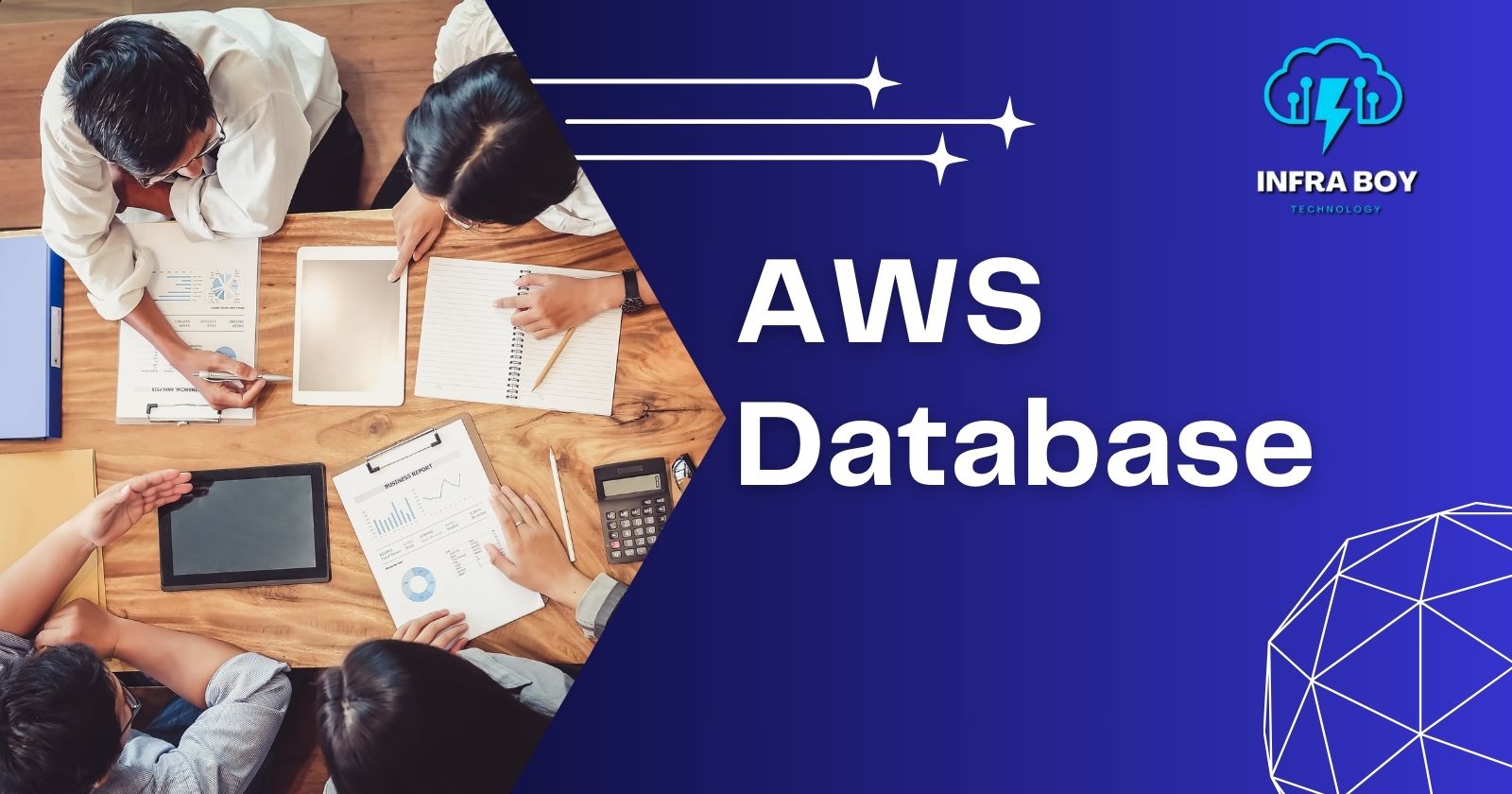AWS Database Services
 Infraboy
InfraboyTable of contents
- 1. Amazon RDS (Relational Database Service)
- 2. Amazon DynamoDB
- 3. Amazon Redshift
- 4. Amazon ElastiCache
- 5. Amazon Neptune
- 6. Amazon DocumentDB
- 7. Amazon QLDB
- 8. Amazon Timestream
- 9. Amazon Keyspaces
- Key Features of AWS Database Services
- Benefits of Using AWS Database Services
- Common Use Cases
- Considerations for Choosing the Right Database Service
- Differences between Amazon DynamoDB, Amazon Redshift, and Amazon Aurora:
- Detailed Notes:
- Conclusion

Amazon Web Services (AWS) offers a broad range of database services designed to cater to various needs, from relational databases to NoSQL and in-memory data stores. Here’s a detailed overview for your blog:
1. Amazon RDS (Relational Database Service)
Amazon RDS simplifies the setup, operation, and scaling of relational databases in the cloud. It provides six familiar database engines to choose from:
Amazon Aurora: A MySQL and PostgreSQL-compatible relational database that combines the performance and availability of high-end commercial databases with the simplicity and cost-effectiveness of open-source databases.
MySQL: A widely used open-source relational database.
MariaDB: An enhanced, drop-in replacement for MySQL.
PostgreSQL: An advanced open-source relational database.
Oracle: Offers Oracle Database Enterprise Edition and Standard Edition.
SQL Server: Microsoft’s enterprise-grade relational database.
Key Features:
Automated backups, software patching, monitoring, and scaling.
Multi-AZ (Availability Zone) deployments for high availability.
Read replicas for improved read performance and scalability.
2. Amazon DynamoDB
Amazon DynamoDB is a fully managed NoSQL database service that provides fast and predictable performance with seamless scalability. It supports both document and key-value store models.
Key Features:
Low latency and high throughput.
Fully managed with automatic scaling.
Integrated with AWS Lambda for serverless applications.
Multi-region replication with global tables.
3. Amazon Redshift
Amazon Redshift is a fully managed data warehouse service that makes it simple and cost-effective to analyze all your data using standard SQL and your existing Business Intelligence (BI) tools.
Key Features:
Columnar storage for optimal query performance.
Massively parallel processing (MPP) architecture.
Integration with Amazon S3 and other data lakes.
Advanced security features including encryption and VPC.
4. Amazon ElastiCache
Amazon ElastiCache is a web service that makes it easy to deploy, operate, and scale an in-memory cache in the cloud. The service supports two open-source in-memory caching engines:
Redis: A fast, open-source, in-memory key-value store that supports rich data structures.
Memcached: A widely adopted memory object caching system.
Key Features:
Improves the performance of web applications by allowing you to retrieve information from fast, managed, in-memory caches instead of relying entirely on slower disk-based databases.
Automatic failure detection and recovery.
Advanced security features.
5. Amazon Neptune
Amazon Neptune is a fast, reliable, fully managed graph database service that makes it easy to build and run applications that work with highly connected datasets.
Key Features:
Supports popular graph models: Property Graph and RDF (Resource Description Framework).
Optimized for storing billions of relationships and querying the graph with milliseconds latency.
Fully managed with automated backups and replication.
6. Amazon DocumentDB
Amazon DocumentDB (with MongoDB compatibility) is a scalable, highly durable, and fully managed database service for operating mission-critical MongoDB workloads.
Key Features:
Designed to be compatible with MongoDB 3.6 and 4.0 APIs.
Fully managed with automated backups and updates.
Scalability with up to 15 read replicas.
7. Amazon QLDB
Amazon Quantum Ledger Database (QLDB) is a fully managed ledger database that provides a transparent, immutable, and cryptographically verifiable transaction log.
Key Features:
Keeps a complete and verifiable history of changes over time.
Fully managed, highly scalable, and serverless.
Use cases include finance, supply chain, and insurance.
8. Amazon Timestream
Amazon Timestream is a fast, scalable, and serverless time series database service for IoT and operational applications that makes it easy to store and analyze trillions of events per day.
Key Features:
Optimized for time series data with built-in time series functions.
Serverless with automatic scaling.
Integrated with AWS IoT and analytics services.
9. Amazon Keyspaces
Amazon Keyspaces (for Apache Cassandra) is a scalable, highly available, and managed Apache Cassandra-compatible database service.
Key Features:
Compatible with Cassandra Query Language (CQL).
Fully managed with serverless scaling.
Seamless integration with other AWS services.
Key Features of AWS Database Services
Fully Managed Services:
Automatic patching, backups, and recovery.
Scalability without manual intervention.
High Availability and Durability:
Multi-AZ deployments.
Automated backups and snapshots.
Cross-region replication for disaster recovery.
Performance:
Low latency and high throughput.
Optimized for specific workloads (e.g., in-memory caching, time series data).
Security:
Encryption at rest and in transit.
Fine-grained access control.
Compliance with various industry standards (e.g., HIPAA, GDPR).
Cost-Effectiveness:
Pay-as-you-go pricing models.
Reserved instances and savings plans for cost optimization.
Serverless options to reduce costs for sporadic workloads.
Benefits of Using AWS Database Services
Scalability:
Seamless scaling both vertically and horizontally.
Ability to handle varying workloads without performance degradation.
Integration with AWS Ecosystem:
Easy integration with other AWS services (e.g., Lambda, S3, Kinesis).
Unified management through AWS Management Console and CLI.
Flexibility:
Support for multiple database engines and models (relational, NoSQL, graph, etc.).
Compatibility with existing tools and applications.
Global Reach:
Availability in multiple AWS regions around the world.
Support for multi-region deployments and global applications.
Common Use Cases
Web and Mobile Applications:
Use RDS for relational data storage.
DynamoDB for scalable NoSQL storage.
Data Warehousing and Analytics:
Amazon Redshift for large-scale data warehousing.
Timestream for time series data analytics.
Caching and Session Management:
- ElastiCache with Redis or Memcached for in-memory caching.
IoT Applications:
DynamoDB for handling large volumes of IoT data.
Timestream for time series data from IoT devices.
Financial and Ledger Applications:
Amazon QLDB for immutable and verifiable transaction logs.
RDS or DynamoDB for transactional data.
Considerations for Choosing the Right Database Service
Data Model Requirements:
Relational vs. NoSQL vs. graph databases.
Structured vs. unstructured data.
Performance and Scalability Needs:
Expected read and write throughput.
Latency requirements.
Operational Complexity:
Level of management and maintenance required.
In-house expertise with specific database technologies.
Cost Implications:
Budget constraints and cost optimization strategies.
Long-term vs. short-term storage needs.
Compliance and Security:
Industry-specific compliance requirements.
Data residency and encryption needs.
Differences between Amazon DynamoDB, Amazon Redshift, and Amazon Aurora:
| Feature/Aspect | Amazon DynamoDB | Amazon Redshift | Amazon Aurora |
| Database Type | NoSQL (Key-Value, Document Store) | Data Warehouse (Columnar Storage) | Relational Database |
| Use Cases | Web and mobile backends, IoT applications, gaming | Data warehousing, analytics, big data workloads | Transactional applications, web and mobile backends |
| Data Model | Schema-less, key-value pairs, documents | Relational, columnar | Relational, MySQL and PostgreSQL compatible |
| Scalability | Horizontal scaling, auto-scaling, on-demand | Scalable up to petabytes, MPP architecture | Automatic scaling, read replicas, multi-AZ |
| Performance | Single-digit millisecond response times | High performance for complex queries, columnar storage | High performance with SSD storage, read replicas |
| Storage Capacity | Virtually unlimited | Up to 2 PB per cluster | Up to 128 TiB |
| Replication | Multi-region replication with global tables | Not inherently multi-region | Cross-region replication, read replicas |
| Backup & Recovery | On-demand backup, point-in-time recovery | Automated and manual snapshots | Continuous backup, point-in-time recovery |
| Query Language | DynamoDB API, PartiQL | SQL | SQL |
| Consistency Models | Eventual and strong consistency | Strong consistency | Strong consistency |
| Data Ingestion | Streams, DynamoDB Streams | COPY command, data pipeline integrations | Amazon RDS Data API, Aurora Serverless |
| Security | Encryption at rest and in transit, IAM policies | Encryption at rest and in transit, IAM roles | Encryption at rest and in transit, IAM policies |
| Cost Structure | Pay-per-request (on-demand) or provisioned throughput | Pay per node/hour, storage, and data transfer | Pay per instance/hour, storage, and I/O operations |
| Integration | AWS Lambda, AWS IoT, AWS Glue | BI tools (e.g., Tableau), Amazon S3, AWS Glue | Amazon RDS, AWS Lambda, Amazon S3 |
| Automatic Scaling | Yes, with on-demand and provisioned capacity | No, requires manual intervention | Yes, with Aurora Auto Scaling and Aurora Serverless |
| Regions Availability | Available in multiple regions | Available in multiple regions | Available in multiple regions |
Detailed Notes:
Amazon DynamoDB:
Designed for high availability and durability, with automatic data replication across multiple AWS availability zones.
Ideal for applications requiring rapid response times and flexible data models.
Amazon Redshift:
Optimized for complex analytical queries and large-scale data warehousing tasks.
Uses columnar storage, which is efficient for read-heavy queries and data compression.
Amazon Aurora:
Provides the performance and availability of commercial databases at a lower cost.
Compatible with MySQL and PostgreSQL, making it easy to migrate existing applications.
Features such as read replicas, multi-AZ deployment, and continuous backup offer high availability and durability.
Conclusion
Choosing between Amazon DynamoDB, Amazon Redshift, and Amazon Aurora depends on your specific use case and requirements:
DynamoDB is best suited for high-performance applications requiring flexible data models and scalable, low-latency access.
Redshift is ideal for data warehousing and analytics, providing high performance for complex queries and large datasets.
Aurora is optimal for traditional relational database workloads, offering high availability, scalability, and compatibility with MySQL and PostgreSQL.
Subscribe to my newsletter
Read articles from Infraboy directly inside your inbox. Subscribe to the newsletter, and don't miss out.
Written by

Infraboy
Infraboy
We will provide all kinds of the note which is related to IT infra courses like : Networking , Cloud Computing , AWS , CEH , Cyber Security